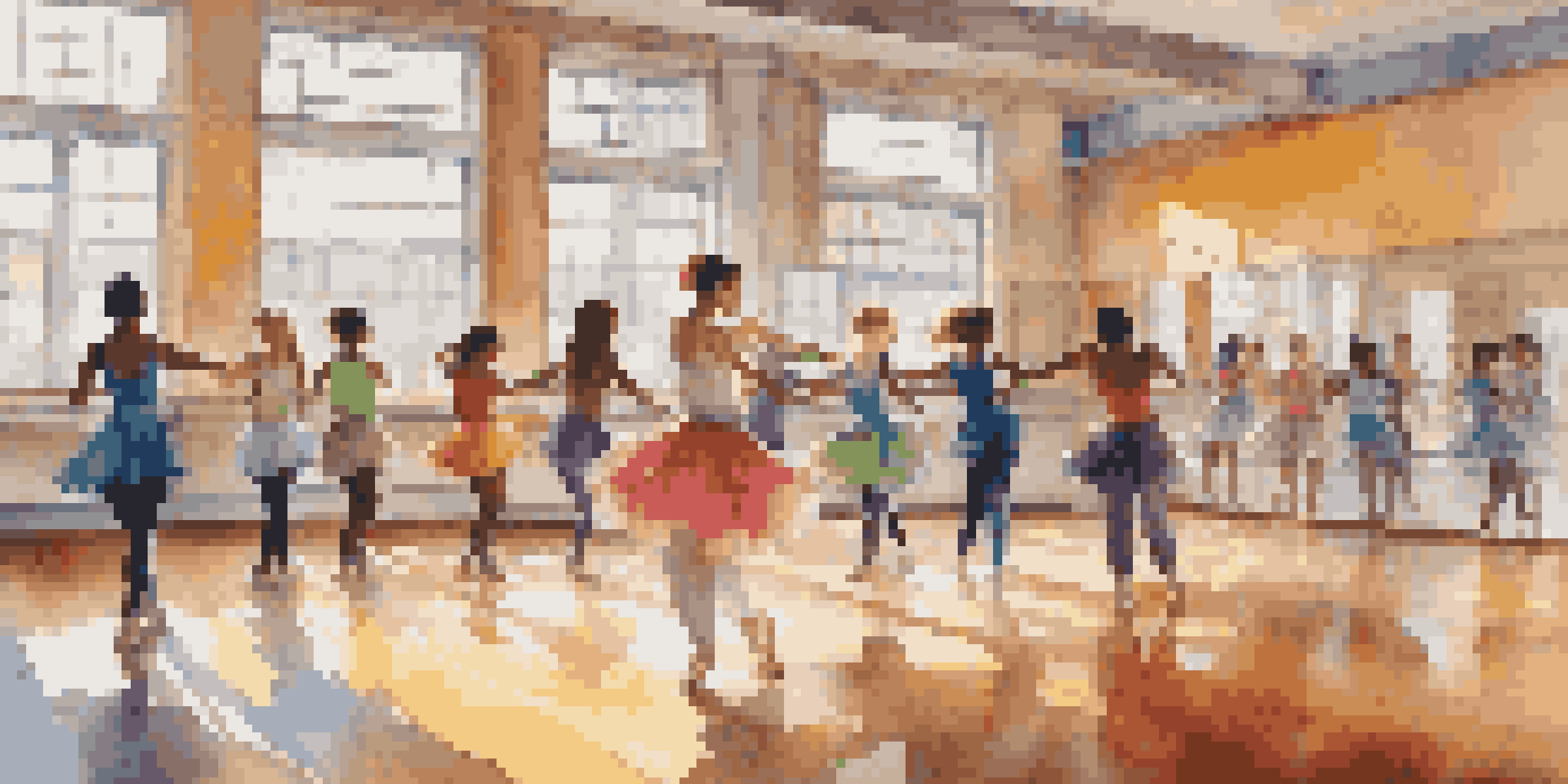Dance Education Policy: Advocating for Funding and Support

Understanding Dance Education and Its Impact
Dance education goes beyond just learning steps; it cultivates creativity, discipline, and self-expression. Students who engage in dance often find a deeper connection to their bodies and emotions, which can enhance their overall well-being. Moreover, dance fosters teamwork and collaboration, skills that are essential in both personal and professional realms.
Dance is the hidden language of the soul.
In many communities, dance programs serve as a crucial outlet for youth, offering them a safe space to explore their identities while promoting cultural awareness. The ripple effects of quality dance education can be seen in improved academic performance and personal growth. Ultimately, investing in dance education is investing in future generations.
However, despite its benefits, dance education often struggles to secure the necessary funding and resources. This lack of support can lead to diminished program quality and accessibility, leaving many students without the opportunity to experience the transformative power of dance.
The Current State of Dance Education Funding
As it stands, funding for dance education varies significantly between regions. Some schools have robust programs, complete with experienced instructors and performance opportunities, while others may lack even basic supplies for dance classes. This disparity raises concerns about equity in education and access to the arts.

Many dance programs are funded through a patchwork of grants, donations, and school budgets, which can be unpredictable and insufficient. This precarious financial situation often leads to program cuts or the elimination of vital extracurricular opportunities. The lack of consistent funding not only affects the quality of dance education but also the morale of students and educators alike.
Dance Education Enhances Well-Being
Engaging in dance education cultivates creativity, discipline, and emotional connection, promoting overall well-being among students.
To advocate for stronger funding, it's essential to highlight the proven benefits of dance education. Studies have shown that students engaged in the arts, including dance, perform better academically, have higher self-esteem, and develop crucial life skills. By presenting these facts, advocates can create a compelling case for increased investment in dance programs.
The Role of Policy in Dance Education Funding
Education policy plays a critical role in determining how resources are allocated to dance programs. Policymakers have the power to advocate for arts education by ensuring it is included in curriculum standards and funding initiatives. This can help create a more structured approach to supporting dance education across various educational institutions.
The only way to make sense out of change is to plunge into it, move with it, and join the dance.
Additionally, policies that encourage partnerships between schools and local arts organizations can enhance funding opportunities and resource sharing. These collaborations can lead to innovative programs that benefit both students and the community. Such initiatives not only enrich the educational experience but also foster a greater appreciation for the arts.
Advocating for policy changes requires a concerted effort from educators, parents, and community members. By coming together and voicing the importance of dance education, stakeholders can influence decision-makers to prioritize funding and support for these invaluable programs.
Engaging Communities in Dance Advocacy
Community engagement is pivotal in advocating for dance education funding. When local stakeholders, including parents and business leaders, rally together to support dance programs, they amplify their voices and create a more compelling case for funding. Community support can take many forms, from attending school board meetings to organizing fundraising events.
Moreover, showcasing student performances can also draw attention to the importance of dance in education. These events provide opportunities for students to shine while reminding the community of the benefits dance brings. By highlighting success stories and positive outcomes, communities can foster a culture that values and prioritizes arts education.
Funding Disparities Impact Access
The inconsistent funding for dance education across regions raises concerns about equity and access to arts education for students.
Building strong relationships with local legislators can also enhance advocacy efforts. When community members establish connections with policymakers, they can more effectively communicate the needs and benefits of dance education, paving the way for increased funding and support.
The Importance of Building a Strong Advocacy Network
Creating a network of advocates is essential for sustaining efforts to secure dance education funding. This network can consist of educators, parents, students, and local artists who share a passion for dance. By collaborating and sharing resources, advocates can amplify their messages and reach a broader audience.
Training and educating advocates on effective communication strategies can further enhance their impact. Workshops and seminars can equip individuals with the skills needed to articulate the value of dance education and navigate the often-complex world of policy advocacy. A well-informed network is a powerful tool for driving change.
Additionally, leveraging social media can help expand the reach of advocacy efforts. By sharing success stories, upcoming events, and calls to action online, advocates can engage a wider audience and foster a sense of community around dance education.
Case Studies of Successful Dance Education Programs
Examining successful dance education programs can provide valuable insights for advocacy efforts. For instance, some schools have implemented comprehensive dance curricula that integrate various styles and techniques, attracting diverse student populations. These programs often receive funding through partnerships with local arts organizations, demonstrating the effectiveness of collaboration.
Another example is community-based dance initiatives that provide free or low-cost classes to underserved populations. These programs not only enhance access to dance education but also foster community engagement and cultural appreciation. By showcasing such success stories, advocates can illustrate the tangible benefits of investing in dance education.
Community Advocacy Drives Change
Building strong community support and advocacy networks is crucial for securing funding and promoting the importance of dance education.
Sharing these case studies with policymakers and the public can inspire similar initiatives in other communities. The more advocates can highlight successful models, the easier it becomes to make a case for the necessary funding and support needed to replicate their success.
The Future of Dance Education Advocacy
Looking ahead, the future of dance education advocacy is promising, but it requires ongoing commitment and collaboration. As awareness of the benefits of dance education continues to grow, so too does the potential for increased funding and support. Advocates must remain diligent in their efforts to communicate the value of dance education to both policymakers and the public.
Emerging trends in education, such as the integration of technology and online learning, also present new opportunities for dance education. By adapting to these changes, programs can attract more students and potentially secure additional funding sources. Embracing innovation while staying true to the core values of dance will be key to future success.

Ultimately, a united front is essential for driving meaningful change. By continuing to advocate for funding and support, we can ensure that dance education remains an integral part of our educational landscape, enriching the lives of students for generations to come.